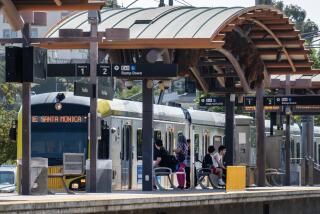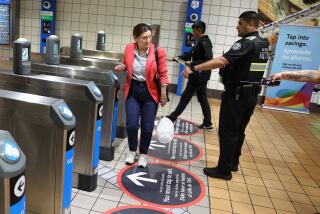California Commute: Cheap gas may not lead to drop in transit ridership, experts say
Since the start of the summer, gasoline prices in Los Angeles County have tumbled 40%, from more than $4 to $2.52, sparking gleeful social media posts and long lines at the cheapest gas stations.
But the enthusiasm is tempered with concern from local transit officials, who say cheap gasoline takes away a key incentive to ride the bus or train in a region where commuting is still overwhelmingly done by car. And in fact, for every month that gas prices declined in 2014, so did the Los Angeles County Metropolitan Transportation Authorityâs ridership figures. In the second half of the year, the number of riders systemwide fell by 4% compared with 2013.
But, experts say, donât be fooled: Although there appears to be a connection, correlation is not causation.
Itâs well documented that transit ridership gets a bump when gas prices soar. If prices at the pump increase by 100%, people drive about 10% less, said Marlon Boarnet, a USC urban planning professor. Some of that decrease in driving leads to higher transit use, but many trips can be done on foot or in a carpool. Other trips can be eliminated.
The effect of cheap gas on transit hasnât been studied as rigorously. Experts say thatâs because gasoline prices crater so rarely that there arenât many opportunities to dig into the data â and because economists know what to expect.
âFalling gas prices donât lead to much of a decrease in ridership, if any,â Boarnet said. âYouâre looking at zero to two percentage points change, at most.â
In Los Angeles, cheap gas alone doesnât make driving affordable for low-income residents, Metroâs main customer base. Four in five passengers donât have access to a private vehicle, and more than half of riders live below the federal poverty threshold: $11,670 for one person and $23,850 for a family of four.
âTaking transit versus driving here basically depends on whether youâre rich or youâre poor,â said Jan K. Brueckner, a UC Irvine professor who studies urban economics. âThe margin of transit riders affected by lower gas prices is very narrow.â
Purchasing, insuring and repairing cars costs far more than filling the tank. Of the estimated $8,835 that the average Los Angeles household spent on transportation in 2012, just 7% went to transit fares and taxis, while 33% went toward gas and 60% toward other vehicle expenses, according to the most recent data available from the U.S. Bureau of Labor Statistics.
If a slim margin of discretionary transit users shift back to their cars, the overall effect on Metro ridership should be minimal. That separates Los Angeles from other major U.S. cities, where subway cars and buses often show a broad cross-section of income and race.
âIf youâre looking at Chicago, New York or Washington, D.C., this would be a different question,â Brueckner said.
At a gas station in Inglewood on Friday, Vanessa Bustillos filled up her Toyota Tundra pickup in preparation for a drive to Northern California for the long weekend. At $65 for a full tank, she paid $20 less than she would have six months ago. âI would have driven anyway,â she said. âBut itâs nice to save some money.â
The biggest influence on transit ridership is the health of the economy, experts say. During the Great Recession, as income levels dropped and household budgets tightened, transit ridership hit record highs across the United States. Some of the strongest ridership months in 2008 and 2009 corresponded with low fuel prices.
Metro officials note, with some concern, that as the economy rebounds, more households are buying new cars. In the first 11 months of 2014, Southland residents registered 8% more new cars than in 2013, according to the most recent data from L.A. Times/cars.com.
Any minor shifts in ridership due to lower gas prices wonât appear in Metroâs ridership figure for several more months, spokesman Marc Littman said, because the agencyâs ridership estimates are based on a six-month average of data samples taken across all lines in the system.
âWhen gas prices spike, we donât see ridership gains until several months later,â Littman said. âIt takes a while for this stuff to percolate through.â
Itâs more likely, experts said, that the fare increase in September led to a temporary drop in ridership while passengers adjusted to higher costs.
This also was the first year that Metroâs ridership figures included several months of data from stations where turnstiles are now locked. For a year, ending in June, the agency locked fare gates at 40 of the systemâs 80 rail stations in an attempt to make it more difficult for riders to board without paying. Analysts say that could lead to fewer people boarding as well.
âYou canât pinpoint which single factor causes ridership to decrease,â said Dan Nguyen, Metroâs deputy executive officer for service performance and scheduling. âBut we do need to make an effort to attract new riders and retain the riders we have.â
Have an idea, gripe or question? Times staff writers Laura J. Nelson and Dan Weikel write California Commute and are looking for leads. Send them along.
For more transportation news, follow @laura_nelson on Twitter.
More to Read
Sign up for Essential California
The most important California stories and recommendations in your inbox every morning.
You may occasionally receive promotional content from the Los Angeles Times.











